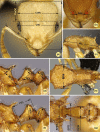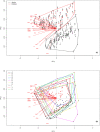Insect morphometry is reproducible under average investigation standards
- PMID: 33437450
- PMCID: PMC7790639
- DOI: 10.1002/ece3.7075
Insect morphometry is reproducible under average investigation standards
Abstract
Morphometric research is being applied to a growing number and variety of organisms. Discoveries achieved via morphometric approaches are often considered highly transferable, in contrast to the tacit and idiosyncratic interpretation of discrete character states. The reliability of morphometric workflows in insect systematics has never been a subject of focused research, but such studies are sorely needed. In this paper, we assess the reproducibility of morphometric studies of ants where the mode of data collection is a shared routine.We compared datasets generated by eleven independent gaugers, that is, collaborators, who measured 21 continuous morphometric traits on the same pool of individuals according to the same protocol. The gaugers possessed a wide range of morphometric skills, had varying expertise among insect groups, and differed in their facility with measuring equipment. We used intraclass correlation coefficients (ICC) to calculate repeatability and reproducibility values (i.e., intra- and intergauger agreements), and we performed a multivariate permutational multivariate analysis of variance (PERMANOVA) using the Morosita index of dissimilarity with 9,999 iterations.The calculated average measure of intraclass correlation coefficients of different gaugers ranged from R = 0.784 to R = 0.9897 and a significant correlation was found between the repeatability and the morphometric skills of gaugers (p = 0.016). There was no significant association with the magnification of the equipment in the case of these rather small ants. The intergauger agreement, that is the reproducibility, varied between R = 0.872 and R = 0.471 (mean R = 0.690), but all gaugers arrived at the same two-species conclusion. A PERMANOVA test revealed no significant gauger effect on species identity (R 2 = 0.69, p = 0.58).Our findings show that morphometric studies are reproducible when observers follow the standard protocol; hence, morphometric findings are widely transferable and will remain a valuable data source for alpha taxonomy.
Keywords: entomology; measurement error; morphology; repeatability; species delimitation; taxonomy.
© 2020 The Authors. Ecology and Evolution published by John Wiley & Sons Ltd.
Conflict of interest statement
The authors declare no competing financial and nonfinancial interests.
Figures



Similar articles
-
Assessment and quantification of sources of variability in breast apparent diffusion coefficient (ADC) measurements at diffusion weighted imaging.Eur J Radiol. 2015 Sep;84(9):1729-36. doi: 10.1016/j.ejrad.2015.05.032. Epub 2015 Jun 1. Eur J Radiol. 2015. PMID: 26078100
-
Ultrasound Shear Wave Elastography for Liver Disease. A Critical Appraisal of the Many Actors on the Stage.Ultraschall Med. 2016 Feb;37(1):1-5. doi: 10.1055/s-0035-1567037. Epub 2016 Feb 12. Ultraschall Med. 2016. PMID: 26871407
-
Small class sizes for improving student achievement in primary and secondary schools: a systematic review.Campbell Syst Rev. 2018 Oct 11;14(1):1-107. doi: 10.4073/csr.2018.10. eCollection 2018. Campbell Syst Rev. 2018. PMID: 37131395 Free PMC article.
-
Repeatability, Reproducibility, Separative Power and Subjectivity of Different Fish Morphometric Analysis Methods.PLoS One. 2016 Jun 21;11(6):e0157890. doi: 10.1371/journal.pone.0157890. eCollection 2016. PLoS One. 2016. PMID: 27327896 Free PMC article.
-
Morphometric Optical Imaging of Microporated Nail Tissue: An Investigation of Intermethod Agreement, Reliability, and Technical Limitations.Lasers Surg Med. 2021 Aug;53(6):838-848. doi: 10.1002/lsm.23304. Epub 2020 Aug 8. Lasers Surg Med. 2021. PMID: 32770696
Cited by
-
Classifying fossil Darwin wasps (Hymenoptera: Ichneumonidae) with geometric morphometrics of fore wings.PLoS One. 2022 Nov 17;17(11):e0275570. doi: 10.1371/journal.pone.0275570. eCollection 2022. PLoS One. 2022. PMID: 36395283 Free PMC article.
-
Morphometric Characteristics and Species Identification of Bed Bugs (Hemiptera: Cimicidae) in Eastern Iran.J Arthropod Borne Dis. 2024 Mar 31;18(1):28-36. doi: 10.18502/jad.v18i1.15669. eCollection 2024 Mar. J Arthropod Borne Dis. 2024. PMID: 39005538 Free PMC article.
-
Comparing ant morphology measurements from microscope and online AntWeb.org 2D z-stacked images.Ecol Evol. 2023 Mar 19;13(3):e9897. doi: 10.1002/ece3.9897. eCollection 2023 Mar. Ecol Evol. 2023. PMID: 36950369 Free PMC article.
-
Ectoparasitic fungi Rickia wasmannii infection is associated with smaller body size in Myrmica ants.Sci Rep. 2021 Jul 13;11(1):14355. doi: 10.1038/s41598-021-93583-0. Sci Rep. 2021. PMID: 34257353 Free PMC article.
-
Small workers are more persistent when providing and requiring help in a monomorphic ant.Sci Rep. 2023 Dec 7;13(1):21580. doi: 10.1038/s41598-023-49012-5. Sci Rep. 2023. PMID: 38062073 Free PMC article.
References
-
- Anderson, A. M. , Friis, C. , Gratto‐Trevor, C. L. , Morrison, R. G. , Smith, P. A. , & Nol, E. (2019). Consistent declines in wing lengths of Calidridine sandpipers suggest a rapid morphometric response to environmental change. PLoS One, 14(4), e0213930 10.1371/journal.pone.0213930 - DOI - PMC - PubMed
-
- Anderson, M. J. (2001). A new method for non‐parametric multivariate analysis of variance. Austral Ecology, 26, 32–46. 10.1111/j.1442-9993.2001.01070.pp.x - DOI
-
- Aristotle , Ross, W. D. , & Smith, J. A. (1928–1963). The works of Aristotle. Oxford: Clarendon Press.
-
- Baroni Urbani, C. (1998). The number of castes in ants, where major is smaller than minor and queens wear the shield of the soldiers. Insectes Sociaux, 45, 315–333. 10.1007/s000400050091 - DOI
Associated data
LinkOut - more resources
Full Text Sources

